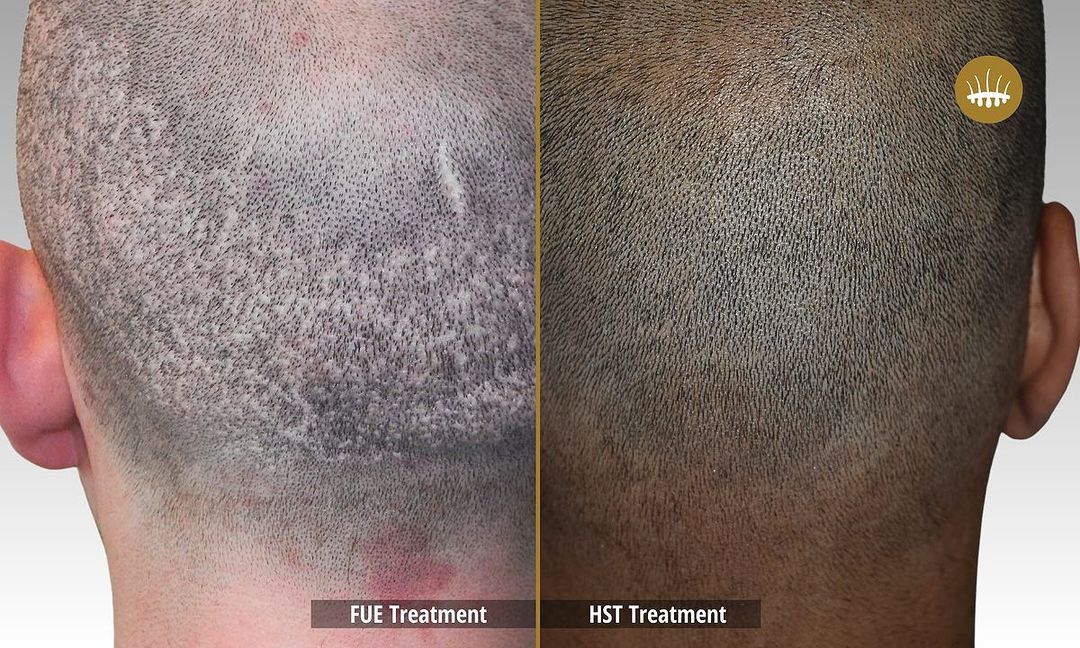Receive a hair transplant in Palermo with no scarring and achieve a natural look






HST: DOES NOT MOVE THE HAIR, MULTIPLIES IT
It is not a classic transplant technique like FUE, which consists of moving follicular units taken from the donor area located at the back of the head and transplanted into the recipient area. Instead, it is a technique that takes only portions of follicular units using needles half a millimeter in size. The interest of such small partial samples is inherent in the phenomenon of hair stem cells. These stem cells are found with small sampling both in the portion that remains in situ and in the portion that is taken. This fact is crucial because from each group of stem cells exactly one follicular unit grows back exactly the same as the one of origin.
It is clear that if two follicular units are generated from one follicular unit, we can speak with full knowledge of the facts about their multiplication. It is very important to reflect on how this phenomenon of multiplication can be extremely decisive in cases of sparse donor areas or exploited by other interventions or in the restoration of large types of alopecia. The hair needs nine months to grow again and recreate the size of the follicular units similar to the one it started with. Once the donor area has been regenerated, further interventions are possible, allowing for the desired restoration.
HST: ONLY IN HAIR SCIENCE CLINICS
This technique is practiced only in specialized clinics, called Hair Science Clinics, where doctors are trained at the Hair Science Academy in Maastricht, home of the research laboratory at the origin of the patent. Patients undergo meticulous microscopic sampling that results in needle-sized wounds. The consequence is that the tiny wounds heal within two or three days, that there is no bleeding and that it is not necessary to bandage the patient’s head after the operation is finished. The post-operative course is therefore extremely rapid and free from annoying traumatic consequences. Within a few days, the garment is extremely presentable and it is not necessary to remain in isolation as is the case in many other cases. The extremely small size of the grafts also allows a dense reconstruction in the donor area, the grafts being able to be placed very close to each other.
Extremely thin and tissue-deprived grafts could not survive after extraction, such as a plant without any clods around the roots. For this reason, the grafts receive energy for their survival by immersion in a bath containing extracellular matrix elements. The stay in the bath, called medium, is at least two hours after extraction. During the first phase, called extraction, which lasts a few hours, all the grafts are taken from the patient’s neck, which contains follicular units that are insensitive to dihydrotestosterone and are therefore free from falling. In the afternoon, replanting is carried out in the recipient area. Very small holes are drilled on the patient’s skin, in order to be able to insert, at a very close distance as the tiny size of the grafts allows, all the samples that have been prepared for this purpose.
The result is extremely natural, with no scars, with an absolutely unmatched density. This process is also possible for the reconstruction of eyebrows, for the increase of density of patchy beards, to restore scars for example left by FUT FUSS strip interventions. In addition, Hair is also a reconstructive technique, successfully used, as several scientific publications illustrate, on patients suffering from skin burns.
THE STAGES OF HST HAIR TRANSPLANTATION
How does an HST intervention take place? The patient is previously subjected to a trichological examination by specialist doctors. This visit, for which the patient is invited to fill in a detailed medical history form in which he must describe his path related to the capillary problem for which he consults (whether he has already undergone operations or not or how his baldness has evolved)
CONSULTATION BEFORE SURGERY
The purpose of the consultation visa is to define the project shared with the patient. In fact, although the patient generally has very high expectations, he must be put in a position to understand what his real situation is. That is, he must be aware of the real conditions in his donor area. This is ethically very important in order not to fall into the illusion that unfortunately many other operators induce patients. It must be understood that the stock of follicular units that the patient has available is limited.
When, unfortunately, the patient succumbs to the seduction proposed without too many scruples by unethical operators, the promises made, also assisted by exaggeratedly low economic proposals, the damage that can result from it is sometimes extremely difficult to restore. Well, the purpose of the consultation is to ascertain the real potential in terms of transplantation offered by a donor area. This must be related to the area to be restored. The best donor areas, equipped with the largest capital of follicular units available, can provide 4 to 6 thousand follicular units. Then nothing more can be extracted from this area. If the extent of alopecia is extensive, then the patient will have to settle for a partial or even incomplete restoration.
A NETWORK OF REGIONAL TRICHOLOGISTS
The Hair Science Clinics, the only ones where it is possible, exclusively, to undergo HST surgery, are clinics specialized in regenerative medicine, where the science applied to stem cells is focused on rejuvenation. The only Hair Science Clinic in Italy is currently in Milan. Others may be opened in other important locations in the future, however a network of trichologists allows patients to be consulted at their places of residence, while for the operation they will have to go to Milan
Telephone
Where we are
Milan, Lausanne
hasci.italia@gmail.com
